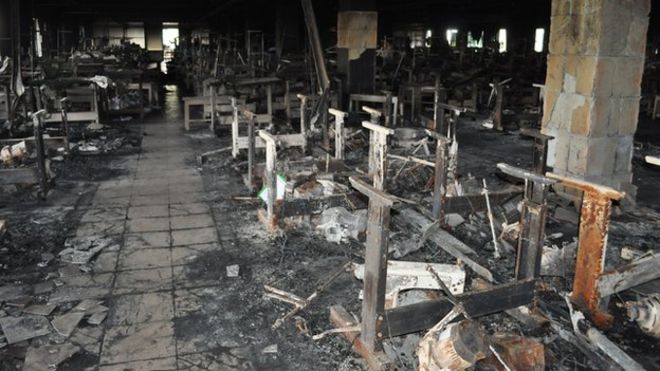
Dhaka, Bangladesh (BBN)-Factory fires pose one of the greatest dangers to Bangladesh’s garment workers.
After the 2013 factory collapse at Rana Plaza, more than 200 clothing brands from around the world signed a binding commitment to create (pdf) a Bangladeshi garment industry “in which no worker needs to fear fires, building collapses, or other accidents that could be prevented with reasonable health and safety measures”, reports the Quartz.com.
The first brand to sign the commitment was H&M, which is the single largest buyer of garments from Bangladesh. But a study released Oct. 1 (pdf) by the Clean Clothes Campaign, in collaboration with several labor groups, says the company is “dramatically behind schedule” in making actual improvements in the factories it sources from. Many of those delayed improvements would ensure worker safety in case of a fire.
What’s more worrisome, the report only looked at H&M’s “Platinum” and “Gold” suppliers—the factories that supposedly boast the highest standards in labor and environmental protections.
They account for 56 of the 229 factories H&M uses in Bangladesh.
About 61 per cent didn’t have fire exits that met the accord’s standards, which demand that fire exits have enclosed stairwells and fire-rated doors.
Without those measures, exits can quickly fill with smoke in a fire, effectively trapping workers on a factory’s upper floors.
It’s not a small risk. Factory fires are a persistent hazard in Bangladesh, as the New York Times noted after the 2012 fire at Tazreen Fashions that killed 112 people.
“[Lack of appropriate fire exits] is the defect that has been the primary culprit in virtually every mass fatality fire in the Bangladesh garment industry,” the report states, estimating that this violation alone puts nearly 79,000 workers’ lives in danger.
Safety violation yet to be corrected Share of H&M’s “Platinum” and “Gold factories” in Bangladesh with violation Number of workers endangered
Hasn’t removed locking doors 16% 25,500
Hasn’t removed sliding doors and collapsible gates 55% 64,392
Hasn’t created safe fire exits 61% 78,842
Other major fire hazards included lockable doors, as well as sliding doors and collapsible gates, all of which can make it difficult for workers to escape quickly in an emergency.
The Clean Clothes campaign is a coalition of European organizations that advocates for garment workers’ rights. For this report, it collaborated with the International Labor Rights Forum, Maquila Solidarity Network, and Worker Rights Consortium, with research assistance from Fordham University’s School of Law.
A spokesperson for the Clean Clothes Campaign told Quartz the report focused on H&M because it is the largest buyer from Bangladesh, and therefore has significant leverage in the country.
H&M has also “communicated to consumers through their sustainability reports that all significant repairs are complete,” according to the spokesperson.
The report was a way to independently check on those claims. Its analysis is based on publicly available information from factory-inspection reports and “corrective action plans” disclosed by the organization behind the accord.
H&M issued a press release in response, stating that every factory H&M sources from meets the accord’s minimum requirements for operation, and that progress is happening, if slowly.
It says in the factories where it’s the lead brand sourcing there that “almost 60 per cent of the remediation work is completed and we see good progress.
However, the accord is experiencing some delays of the planned remediation process.”
In a separate statement to Quartz, a company spokesperson explained that delays are due to technical and structural issues in the factories that “require more time and access to technology not available in Bangladesh.”
A heavy workload for the inspection experts was also a factor.
H&M has shown a commitment to improving conditions for workers in its contracted factories.
A few weeks ago, it introduced a “fair wage program” in its Asian factories that will boost workers’ pay.
But as long as it continues operations in factories without proper fire safety, tens of thousands of lives are in danger.
BBN/SK/AD